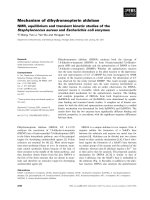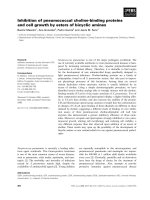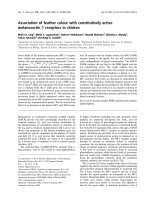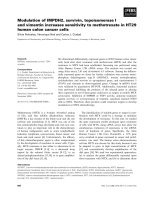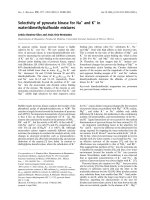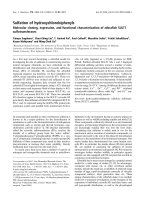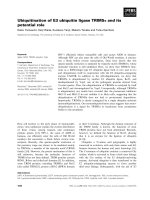báo cáo khoa học:" Associations of reported bruxism with insomnia and insufficient sleep symptoms among media personnel with or without irregular shift work" pdf
Bạn đang xem bản rút gọn của tài liệu. Xem và tải ngay bản đầy đủ của tài liệu tại đây (239.3 KB, 6 trang )
BioMed Central
Page 1 of 6
(page number not for citation purposes)
Head & Face Medicine
Open Access
Research
Associations of reported bruxism with insomnia and insufficient
sleep symptoms among media personnel with or without irregular
shift work
Kristiina Ahlberg*
1,4
, Antti Jahkola
2
, Aslak Savolainen
3
, Mauno Könönen
1,4
,
Markku Partinen
5
, Christer Hublin
2
, Juha Sinisalo
4
, Harri Lindholm
2
,
Seppo Sarna
6
and Jari Ahlberg
1,3
Address:
1
Institute of Dentistry, University of Helsinki, Helsinki, Finland,
2
Finnish Institute of Occupational Health, Helsinki, Finland,
3
Finnish
Broadcasting Company, Helsinki, Finland,
4
Helsinki University Central Hospital, Helsinki, Finland,
5
Rinnekoti Research Centre, Espoo, Finland
and
6
Department of Public Health, University of Helsinki, Helsinki, Finland
Email: Kristiina Ahlberg* - ; Antti Jahkola - ; Aslak Savolainen - ;
Mauno Könönen - ; Markku Partinen - ; Christer Hublin - ;
Juha Sinisalo - ; Harri Lindholm - ; Seppo Sarna - ;
Jari Ahlberg -
* Corresponding author
Abstract
Background: The aims were to investigate the prevalence of perceived sleep quality and
insufficient sleep complaints, and to analyze whether self-reported bruxism was associated with
perceptions of sleep, and awake consequences of disturbed sleep, while controlling confounding
factors relative to poor sleep.
Methods: A standardized questionnaire was mailed to all employees of the Finnish Broadcasting
Company with irregular shift work (n = 750) and to an equal number of randomly selected controls
in the same company with regular eight-hour daytime work.
Results: The response rate in the irregular shift work group was 82.3% (56.6% men) and in the
regular daytime work group 34.3% (46.7% men). Self-reported bruxism occurred frequently (often
or continually) in 10.6% of all subjects. Altogether 16.8% reported difficulties initiating sleep (DIS),
43.6% disrupted sleep (DS), and 10.3% early morning awakenings (EMA). The corresponding figures
for non-restorative sleep (NRS), tiredness, and sleep deprivation (SLD) were 36.2%, 26.1%, and
23.7%, respectively. According to logistic regression, female gender was a significant independent
factor for all insomnia symptoms, and older age for DS and EMA. Frequent bruxism was significantly
associated with DIS (p = 0.019) and DS (p = 0.021). Dissatisfaction with current work shift schedule
and frequent bruxism were both significant independent factors for all variables describing
insufficient sleep consequences.
Conclusion: Self-reported bruxism may indicate sleep problems and their adherent awake
consequences in non-patient populations.
Published: 28 February 2008
Head & Face Medicine 2008, 4:4 doi:10.1186/1746-160X-4-4
Received: 24 August 2007
Accepted: 28 February 2008
This article is available from: />© 2008 Ahlberg et al; licensee BioMed Central Ltd.
This is an Open Access article distributed under the terms of the Creative Commons Attribution License ( />),
which permits unrestricted use, distribution, and reproduction in any medium, provided the original work is properly cited.
Head & Face Medicine 2008, 4:4 />Page 2 of 6
(page number not for citation purposes)
Background
According to recent epidemiological data, Finland has a
unique pattern of insomnia compared with many other
European countries [1]. The high prevalence of insomnia
complaints in the Nordic countries has been explained by
the dark period during midwinter, which is thought to
influence human circadian rhythms.
Shift work has also been shown to affect the circadian
rhythm and to be connected with work related problems
[2,3]. Moreover, irregular shift work has been implicated
as a cause of sleep disorders and tiredness, and may even
expose employees to work hazards [4,5]. Currently in the
Finnish media industry the production and delivery of
radio and TV programmes is in transition from analogue
to digital techniques. Technological changes call for new
professions and competence requirements, whereas some
existing skills are becoming redundant. The 24-hour cul-
ture in modern media work, with its irregular shifts and
night work, may enhance the psychological pressures of
work in an already demanding work environment.
Bruxism has been defined as diurnal or nocturnal
parafunctional jaw muscle activity that includes clench-
ing, bracing, gnashing and grinding of teeth [6]. In clinical
studies the prevalence of bruxism varies greatly, between
6.5% and 88%, while figures in epidemiologic studies are
usually lower, about 6–8% [7-11]. Recent research has
increasingly focused on the unsolved etiology of bruxism,
and at present, the parafunction is more often thought to
be regulated centrally, not peripherally [12]. Evidence also
exists that bruxism appears concomitantly with the tran-
sient arousal response, and thus may be a sign of a sleep
disorder [13,14].
Self-reported bruxism was recently shown among a non-
patient population to have a coherent relationship with
stress and stress-related disorders [15], and possibly to
reflect intrapersonal or interpersonal reactivity [15], or
dissatisfaction [16]. It was also found that disrupted sleep
associates with bruxism and orofacial pain [17], suggest-
ing a vicious circle between those items. However, whilst
clinically detected bruxism may be considered as a sleep
disorder in itself, the associations of self-reported bruxism
and symptoms and consequenses of disturbed sleep
remains far from clear. The aims of the present study, per-
formed in media personnel with or without irregular shift
work, were firstly to investigate the occurrence of insom-
nia symptoms and perceived consequences of insufficient
sleep, and secondly to analyze whether self-reported brux-
ism was associated with them. The effects of some possi-
ble confounding factors (viz., restless legs syndrome,
snoring, gender, age, and dissatisfaction) relative to sleep
quality were controlled.
Methods
In 2003, a standardized questionnaire was mailed to all
employees of the Finnish Broadcasting Company with
irregular shift work (n = 750; 57.0% men) and to an equal
number of randomly selected controls in the same com-
pany with regular eight-hour daytime work (42.4% men).
The mean age of invited subjects was 43.0 (SD 10.4) years
in irregular shift work and 44.8 (SD 10.2) years in day
work. The work duties of the present media personnel
included journalism, broadcasting, programme produc-
tion, technical support and administration.
The overall response rate was 58.3% (53.7% men). The
response rate in the irregular shift work group was 82.3%
(56.6% men) and in the regular daytime work group
34.3% (46.7% men). The mean age of males in shift work
was 45.0 (SD 10.6) years and of females 42.6 (SD 10.7)
years (p < 0.001); the corresponding figures for daytime
workers were 47.4 (SD 9.7) and 45.5 (SD 10.1) years
(NS), respectively [16].
The questionnaire covered demographic items, employ-
ment details, general health experience, physical status,
insomnia symptoms, psychosocial status, stress, work sat-
isfaction and performance. For the present study, the
questionnaire data used were categorized as follows:
a) Demographic data: gender, age.
b) Bruxism: self-assessed frequency of tooth clenching or
grinding (never, seldom, sometimes, often, continually)
[15-17]. Bruxism was considered as frequent when it
occurred 'often' or 'continually'.
c) Dissatisfaction with current workshift schedule (irregu-
lar shifts vs. regular day time work)
d) Insomnia symptoms [18,19]: difficulties initiating
sleep (DIS), disrupted sleep (DS), and early morning
awakenings (EMA). A symptom was considered as present
when it occurred at least three nights per week. EMA in the
irregular work group means that subjects with the symp-
tom woke up before they intended, despite the hour, and
had difficulties in going back to sleep.
e) Perceived consequences of sleep: non-restorative sleep
(NRS) (sustained > 1 month), tiredness (at least 3 days per
week), sleep deprivation (SLD) (subjective need for sleep
1 h > actual sleep time) [20].
f) Neurological and physical confounding factors affect-
ing sleep quality: restless legs syndrome (RLS): presence of
the four essential diagnostic criteria according to the NIH
diagnosis and epidemiology workshop for RLS [21], snor-
Head & Face Medicine 2008, 4:4 />Page 3 of 6
(page number not for citation purposes)
ing: as perceived or reported by bed partner (at least 3
nights per week)
Statistical methods
Student's t-test was used to compare continuous variables.
The χ
2
test was used to study associations between cate-
gorical variables. Logistic regression models were fitted to
analyse the independent effects of the background varia-
bles on the probability of insomnia symptoms (DIS, DS,
EMA) and insufficient sleep consequences (NRS, tired-
ness, SLD). Independent variables included in the six mul-
tivariate models were: gender (male = 0, female = 1), age
(< 45 yr = 0, ≥ 45 yr = 1), irregular shift work (no = 0, yes
= 1), perceived dissatisfaction with current workshift
schedule (no = 0, yes = 1), frequent bruxism (often or con-
tinually) (no = 0, yes = 1), diagnosed RLS (no = 0, yes =
1), and snoring (at least 3 nights per week) (no = 0, yes =
1). The forced entry method was used, i.e. all selected
independent variables were entered in a single step in
each regression model. Both dependent and independent
variables are described in Table 1.
Results
Self-reported bruxism occurred frequently in 10.6% of all
subjects. The bruxism scores were evenly distributed in the
irregular shift work and regular day work groups (NS). A
total of 43.6% reported disrupted sleep and 36.2% per-
ceived their sleep non-restorative. The prevalence figures
for perceived insomnia and insufficent sleep symptoms
and their occurrences by studied subgroups are shown in
Table 1.
According to logistic regression models I-III (Table 2),
female gender was a significant independent factor for all
insomnia symptoms, and older age for DS and EMA. Fre-
quent bruxism was significantly associated with DIS (p =
0.019) and DS (p = 0.021), whilst dissatisfaction with
own work shifts was significantly associated with DIS (p =
0.006) and EMA (p = 0.001). RLS was significantly associ-
ated with DIS (p = 0.023), as also was snoring with DS (p
= 0.010).
Logistic regression models IV-VI (Table 3) revealed that
dissatisfaction with current work shift schedule and fre-
quent bruxism were both significant independent factors
for all variables describing insufficient sleep conse-
quences. Female gender was significantly associated with
NRS (p = 0.044) and tiredness (p = 0.019). Younger age
was significantly associated with NRS (p = 0.009) and SLD
(p < 0.001), and snoring with SLD (p = 0.044).
Discussion
The present study was performed on media personnel
who could be considered as under sustained pressure at
work due to intense on-going technological and organiza-
tional changes. The study formed part of a comprehensive
investigation on shift work and its sleep/awake conse-
quences, and it focused on irregular shift work, which,
Table 1: Overall percentages of perceived insomnia symptoms and insufficient sleep (1st row) and independent variables (1st column)
used in the multivariate models, and occurrences of the studied symptoms by the subgroups. Chi square test.
Insomnia symptoms Insufficient sleep
Total
n = 874
DIS
n = 147
P = DS
n = 381
P = EMA
n = 90
P = NRS
n = 316
P = Tiredness
n = 228
P = SLD
n = 207
P =
Total % 16,8 43,6 10,3 36,2 26,1 23,7
Gender: 0,001 0,035 0,012 0,002 0,007 0,077
male 53,7 13,0 40,3 7,9 31,6 22,4 21,3
female 46,3 21,1 47,4 13,1 41,5 30,4 26,4
Age: 0,308 0,023 0,036 0,001 0,010 <0,001
< 45 58,1 17,9 40,4 8,5 40,6 29,3 28,7
≥ 45 41,9 15,3 48,1 12,8 30,1 21,6 16,7
Irregular shift work: 0,659 0,546 0,388 0,285 0,062 0,843
no 29,4 16,0 42,0 11,7 33,5 21,8 24,1
yes 70,6 17,2 44,2 9,7 37,3 27,9 23,5
Dissatisfied with shifts: 0,001 0,091 0,003 <0,001 <0,001 <0,001
no 80,8 14,7 42,2 8,8 33,3 22,5 21,1
yes 19,2 25,6 49,4 16,7 48,2 41,1 34,5
Frequent bruxism: 0,001 0,006 0,560 0,006 <0,001 <0,001
no 89,4 15,2 42,7 10,5 34,9 24,6 16,1
yes 10,6 29,5 58,0 12,5 52,3 46,6 35,2
RLS: 0,001 0,024 0,002 0,170 0,035 0,354
no 90,6 15,6 42,5 9,3 35,5 25,2 23,3
yes 9,4 31,0 56,3 21,1 43,7 36,6 28,2
Snoring: 0,149 0,004 0,853 0,551 0,215 0,320
no 74,1 15,7 40,7 10,2 36,7 25,0 22,8
yes 25,9 19,9 51,8 10,6 34,5 29,2 26,1
DIS = difficulties initiating sleep, DS = disrupted sleep, EMA = early morning awakening, NRS = non-restorative sleep, SLD = sleep deprivation, RLS = restless legs syndrome
Head & Face Medicine 2008, 4:4 />Page 4 of 6
(page number not for citation purposes)
however, did not emerge as a significant factor in itself.
This was a finding that accords with results from earlier
studies derived from the present data base [15-17].
Unfortunately, despite several postal reminders, we
resulted in a low response rate in the regular day work
group. This was partly expected as the study was transpar-
ently targeted to examine the health effects of irregular
shift work. The invited subjects and respondents in both
shift work and day work groups were similar as regards
gender and age, which, on the other hand, may modestly
suggest that also the day work group could be representa-
tive. Nevertheless, due to the uneven response rates the
present study may have failed in detecting the actual dif-
ferences between these two groups.
However, we studied the associations of self-reported
bruxism with perceived insomnia symptoms and insuffi-
cient sleep using multivariate models in which some con-
founding factors (viz., restless legs syndrome, snoring,
gender, age, and dissatisfaction) relative to sleep quality
were simultaneously controlled. Bearing in mind the
lower response rate in the day work group, the models
were also tested excluding the work group variable, which
did not markedly change the effects of the other inde-
pendent variables. Thus, the work group variable was not
considered to be a confounding factor in the models, and
further, it was eventually included in the present analyses
not to reduce the statistical power.
As the major interest was in self-reported bruxism, the
main findings were that frequent bruxism was signifi-
cantly associated with perceived insomnia symptoms
(except EMA) and insufficient sleep. These associations
also held in the multivariate analyses. The results may
imply a stressful work environment or work dissatisfac-
tion, as discussed earlier [15-17]. The statistically non-sig-
nificant relationship found between bruxism and EMA,
the latter often reportedly associated with depressive
mood [18], has also been suggested to be due to the over-
all low psychological dysfunction found in the present
non-patient population [22].
Using questionnaires, as in the present study, may cause
difficulties in defining the actual prevalence of bruxism; it
may even have been more common among populations
but not reported as a behaviour by individuals because of
its potential subconscious nature. Or, on the other hand,
reporting of bruxism may be influenced by negative affec-
tivity, and individuals with subjective distress may be
more likely to perceive, overreact to and complain about
their sensations. In the present study bruxism was defined
as a subjective perception of tooth grinding or clenching
and the definition includes both sleep and awake
Table 2: Probabilities of insomnia symptoms by studied independent variables. Logistic regression.
n = 874 Difficulties initiating sleep (model I) Disrupted sleep (model II) Early morning awakenings (model III)
OR 95% CI P = OR 95% CI P = OR 95% CI P =
Gender (female) 1,7 1,2–2,6 0,006 1,4 1,0–1,8 0,031 1,7 1,1–2,8 0,020
Age ≥ 45 years 0,8 0,6–1,2 0,313 1,5 1,1–2,0 0,011 1,9 1,2–3,1 0,007
Irregular shift work 0,9 0,6–1,4 0,714 1,1 0,8–1,5 0,690 0,7 0,4–1,1 0,136
Dissatisfied with work shifts 1,9 1,2–2,9 0,006 1,3 0,9–1,9 0,142 2,6 1,5–4,3 0,001
Frequent bruxism 1,9 1,1–3,1 0,019 1,7 1,1–2,7 0,021 1,1 0,6–2,3 0,727
RLS 1,9 1,1–3,2 0,023 1,3 0,8–2,1 0,257 0,8 0,4–1,8 0,655
Snoring 1,4 0,9–2,2 0,125 1,5 1,1–2,1 0,010 1,1 0,6–1,8 0,865
Table 3: Probabilities of non-restorative sleep, tiredness and sleep deprivation by studied independent variables. Logistic regression.
n = 874 Non-restorative sleep (model IV) Tiredness (model V) Sleep deprivation (model VI)
OR 95% CI P = OR 95% CI P = OR 95% CI P =
Gender (female) 1,4 1,0–1,8 0,044 1,5 1,1–2,1 0,019 1,3 0,9–1,8 0,174
Age ≥ 45 years 0,7 0,5–0,9 0,009 0,8 0,5–1,1 0,108 0,5 0,3–0,7 <0,001
Irregular shift work 1,0 0,7–1,4 0,950 1,1 0,8–1,6 0,587 0,8 0,6–1,2 0,296
Dissatisfied with work shifts 1,7 1,2–2,5 0,005 2,2 1,5–3,2 <0,001 1,8 1,2–2,7 0,005
Frequent bruxism 1,7 1,1–2,7 0,021 2,2 1,4–3,5 0,001 1,8 1,1–2,9 0,022
RLS 1,5 0,9–2,5 0,087 1,2 0,7–2,0 0,461 1,1 0,6–1,8 0,857
Snoring 1,0 0,7–1,4 0,988 1,4 0,9–2,0 0,081 1,4 1,0–2,2 0,044
Head & Face Medicine 2008, 4:4 />Page 5 of 6
(page number not for citation purposes)
parafunctions. This also means that sleep and awake brux-
ism cannot be separated here.
Studies have suggested that stress experience and psycho-
social factors may play an important role in the etiology
of bruxism [12]. In contrast, evidence also exists that both
experienced and anticipated stress associate with awake
clenching but would be unrelated to sleep-bruxism
recorded with ambulatory devices [23,24]. Polysomno-
graphic studies have revealed, however, that bruxism
appears concomitantly with the transient arousal
response and has been shown to associate with both sleep
quality and sleep architecture [12,14,25]. On the other
hand, it is well accepted that stress experiences at work are
linked to disturbed sleep and fatigue [26,27]. Thus, if per-
ceived stress or dissatisfaction affect sleep, it could be
assumed that they may concomitantly precipitate or
amplify bruxism. Further, fatique and pain in the mastica-
tory muscles may be a repercussion of this process.
As regards insomnia symptoms both DIS and DS were
found to be markedly more common than previously
reported in Finland [1]. On the other hand, the presence
of EMA did not differ from that reported in the general
population. Also, female gender was overall associated
with insomnia symptoms, which is in line with previous
epidemiologic findings outside Finland [28-30]. In the
present study, age had diverse effects; those ≥ 45 years
more often had DS and EMA but yet the younger subjects
were more likely to report insufficient sleep complaints.
As regards DS this has not been the case in the general
population, but it accords with the results found else-
where. It is noteworthy that DS, also the most significant
factor associated with bruxism, emerged as a major sleep
disturbance affecting nearly half of subjects in the present
non-patient population.
In the multivariate analyses, despite the several associa-
tions found cross-sectionally, RLS was significantly associ-
ated only with DIS. Snoring, in turn, which was bivariately
associated only with DS, was multivariately associated
with both DS and SLD. These findings seem logical and
they also underscore that neurological or physical factors
should be borne in mind when diagnosing and treating
insomnia and insufficient sleep problems. Especially in
the case of RLS a substantial under-recognition may exist
[31-33].
The phenomenon of bruxism may well be genetic in ori-
gin, affected psychosocially or pathophysiologically, but
is most likely centrally regulated [12]. Yet, despite the
increasing number of studies on bruxism, it remains
unclear why self-perceived bruxism and polysomno-
graphically or clinically detected bruxism seem to be
poorly associated and do not share their etiology. Based
on the present study, however, it may be possible to con-
clude that self-reported bruxism indicates sleep problems
and their adherent awake consequences. Also, the found
independently detrimental effect of dissatisfaction on
sleep should not be ignored.
Authors' contributions
KA was the main author of the present manuscript and she
participated in all stages throughout the work. AJ also
took part in planning and writing. AS was the head of the
present research project and was vigorously involved in its
design and coordination. MK made critical comments on
the manuscript and acted as a supervisor. MP and CH
were in charge regarding sleep issues whilst JS and HL
were consulted as regards cardiovascular and occupa-
tional health aspects; they all participated in study plan-
ning and writing. SS and JA performed and interpreted the
statistical analyses. All authors read and approved the
final manuscript.
Acknowledgements
This study was supported by research grants from the Finnish Work Envi-
ronment Fund and the Finnish Dental Society.
References
1. Ohayon M, Partinen M: Insomnia and global sleep dissatisfac-
tion in Finland. J Sleep Res 2002, 11:339-346.
2. Jewett ME, Dijk DJ, Kronauer RE, Dinges DF: Dose-response rela-
tionship between sleep duration and human psychomotor
vigilance and subjective alertness. Sleep 1999, 20:171-179.
3. Kecklund G, Åkerstedt T, Lowden A: Morning work: effects of
early rising on sleep and alertness. Sleep 1997, 20:215-223.
4. Härmä M, Sallinen M, Ranta R, Mutanen P, Müller K: The effect of
an irregular shift system on sleepiness at work in train driv-
ers and railway traffic controllers. J Sleep Res 2002, 11:141-151.
5. Sallinen M, Härmä M, Mutanen P, Ranta R, Virkkala J, Müller K: Sleep-
wake rhythm in an irregular shift system. J Sleep Res 2003,
12:103-112.
6. American Academy of Orofacial Pain, Okeson JP, ed.: Orofacial
pain. Guidelines for Assessment, diagnosis, and manage-
ment. Chicago: Quintessence Publishing Co; 1996.
7. Könönen M, Siirilä H: Prevalence of nocturnal and diurnal brux-
ism in patients with psoriasis. J Prosthet Dent 1988, 60:238-241.
8. Faulkner KD: Bruxism: A review of the literature. Part I. Aust
Dent J 1990, 35:266-276.
9. Lavigne GJ, Montplaisir J: Restless legs syndrome and sleep brux-
ism: prevalence and association among Canadians. Sleep
1994, 17:739-743.
10. Lavigne GJ, Montplaisir J: Bruxism : epidemiology, diagnosis,
pathophysiology, and pharmacology. In Orofacial pain and tem-
poromandibular disorders Edited by: Fricton JR, Dubner RB. New York:
Raven Press; 1995:387-404.
11. Hublin C, Kaprio J, Partinen M, Koskenvuo M: Sleep bruxism based
on self-report in a nationwide twin cohort. J Sleep Res 1998,
7:61-67.
12. Lobbezoo F, Naeije M: Bruxism is mainly regulated centrally,
not peripherally. J Oral Rehabil 2001, 28:
1085-1091.
13. Kato T, Montplaisir JY, Guitard F, Sessle BJ, Lund JP, Lavigne GJ: Evi-
dence that experimentally induced sleep bruxism is a conse-
quence of transient arousal. J Dent Res 2003, 82:284-288.
14. Macaluso GM, Guerra P, Di Giovanni G, Boselli M, Parrino L, Terzano
M: Sleep bruxism is a disorder related to periodic arousals
during sleep. J Dent Res 1998, 77:565-73.
15. Ahlberg J, Savolainen A, Rantala M, Lindholm H, Könönen M:
Reported bruxism and biopsychosocial symptoms: a longitu-
dinal study. Community Dent Oral Epidemiol 2004, 32:307-311.
Publish with Bio Med Central and every
scientist can read your work free of charge
"BioMed Central will be the most significant development for
disseminating the results of biomedical research in our lifetime."
Sir Paul Nurse, Cancer Research UK
Your research papers will be:
available free of charge to the entire biomedical community
peer reviewed and published immediately upon acceptance
cited in PubMed and archived on PubMed Central
yours — you keep the copyright
Submit your manuscript here:
/>BioMedcentral
Head & Face Medicine 2008, 4:4 />Page 6 of 6
(page number not for citation purposes)
16. Ahlberg K, Ahlberg J, Könönen M, Partinen M, Lindholm H, Savolainen
A: Reported bruxism and stress experience in media person-
nel with or without irregular shift work. Acta Odontol Scand
2003, 61:315-318.
17. Ahlberg K, Ahlberg J, Könönen M, Alakuijala A, Partinen M, Savolainen
A: Perceived orofacial pain and its associations with reported
bruxism and insomnia symptoms in media personnel with or
without irregular shift work. Acta Odontol Scand 2005,
63:213-217.
18. American Psychiatric Association (APA): Diagnostic and Statistical Man-
ual of Mental Disorders (DSM-IV) 4th edition. The American Psychiatric
Association, Washington; 1994.
19. American Academy of Sleep Medicine (AASM): The international classi-
fication of Sleep Disorders Revised: Diagnostic and Coding Manual (ICSD)
American Academy of Sleep Medicine, Rochester, MN 1997.
20. Hublin C, Kaprio J, Partinen M, Koskenvuo M: Insufficient sleep –
a population based study in adults. Sleep 2001, 24:392-400.
21. Allen RP, Picchietti D, Hening WA, Trenkwalder C, Walters AS,
Montplaisir J, et al.: Restless legs syndrome: diagnostic criteria,
special considerations, and epidemiology. A report from the
restless legs syndrome diagnosis and epidemiology work-
shop at the National Institutes of Health. Sleep Med 2003,
4:101-119.
22. Rantala MAI, Ahlberg J, Suvinen TI, Savolainen A, Könönen M:
Chronic myofascial pain, disk displacement with reduction
and psychosocial factors in Finnish non-patients. Acta Odontol
Scand 2004, 62:293-297.
23. van Selms MK, Lobbezoo F, Wicks DJ, Hamburger HL, Naeije M:
Craniomandibular pain, oral parafunctions, and psychologi-
cal stress in a longitudinal case study. J Oral Rehabil 2004,
31:738-745.
24. Watanabe T, Ichikawa K, Clark GT: Bruxism levels and daily
behaviours: 3 weeks of measurement and correlation. J Oro-
fac Pain 2003, 17:65-73.
25. Ohayon M, Li K, Guilleminault C: Risk factors for sleep bruxism
in the general population. Chest 2001, 119:63-61.
26. Åkerstedt T, Fredlund P, Gillberg M, Jansson B: Work load and
work hours in relation to disturbed sleep and fatique in a
large representative sample. J Psychosom Res
2002, 53:585-8.
27. Åkerstedt T, Knutsson A, Westerholm P, Theorell T, Alfredsson G,
Kecklund G: Sleep distubances, work stress and work hours. A
cross sectional study. J Psychosom Res 2002, 53:741-748.
28. Pallesen S, Nordhus IH, Nielsen GH, Havik OE, Kvale G, Johnsen BH,
Skjotskift S: Prevalence of insomnia in the adult Norwegian
population. Sleep 2001, 24:771-779.
29. Ohayon M, Zulley J: Correlates of global sleep dissatisfaction in
the German population. Sleep 2001, 24:780-787.
30. Ohayon M, Smirne S: Prevalence and consequences of insomnia
disorders in the general population of Italy. Sleep Med 2002,
3:115-120.
31. Allen RP, Walters AS, Montplaisir J, Hening W, Myers A, Bell TJ,
Ferini-Strambi L: Restless legs syndrome prevalence and
impact: REST general population study. Arch Intern Med 2005,
165:1286-1292.
32. Wenning GK, Kiechl S, Seppi K, Muller J, Hogl B, Saletu M, Rungger
G, Gasperi A, Willeit J, Poewe W: Prevalence of movement dis-
orders in men and women aged 50-89 years (Bruneck Study
cohort): a population-based study. Lancet Neurol 2005,
4:815-820.
33. Pearson VE, Allen RP, Dean T, Gamaldo CE, Lesage SR, Earley CJ:
Cognitive deficits associated with restless legs syndrome
(RLS). Sleep Med 2006, 7:25-30.
